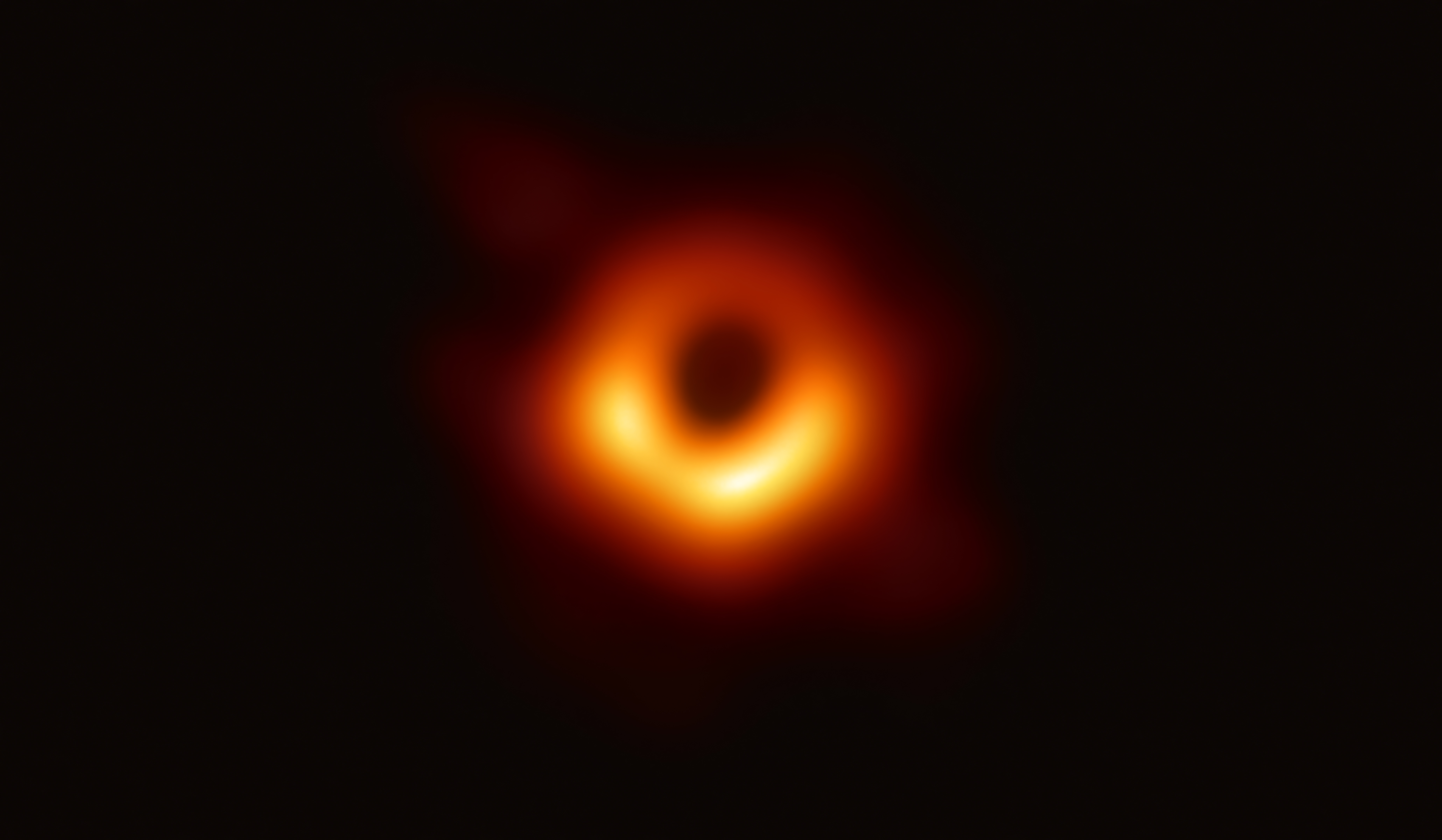|
Quasars
A quasar ( ) is an extremely Luminosity, luminous active galactic nucleus (AGN). It is sometimes known as a quasi-stellar object, abbreviated QSO. The emission from an AGN is powered by accretion onto a supermassive black hole with a mass ranging from millions to tens of billions of solar masses, surrounded by a gaseous Accretion disk, accretion disc. Gas in the disc falling towards the black hole heats up and releases energy in the form of electromagnetic radiation. The radiant energy of quasars is enormous; the most powerful quasars have luminosity, luminosities thousands of times greater than that of a galaxy such as the Milky Way. Quasars are usually categorized as a subclass of the more general category of AGN. The redshifts of quasars are of Expansion of the universe, cosmological origin. The term originated as a Contraction (grammar), contraction of "quasi-stellar ''[star-like]'' radio source"—because they were first identified during the 1950s as sources of radio-wave ... [...More Info...] [...Related Items...] OR: [Wikipedia] [Google] [Baidu] |
Active Galactic Nucleus
An active galactic nucleus (AGN) is a compact region at the center of a galaxy that emits a significant amount of energy across the electromagnetic spectrum, with characteristics indicating that this luminosity is not produced by the stars. Such excess, non-stellar emissions have been observed in the radio waves, radio, microwave, infrared, visible spectrum, optical, ultra-violet, X-ray and gamma ray wavebands. A galaxy hosting an AGN is called an active galaxy. The non-stellar radiation from an AGN is theorized to result from the accretion (astrophysics), accretion of matter by a supermassive black hole at the center of its host galaxy. Active galactic nuclei are the most luminous persistent sources of electromagnetic radiation in the universe and, as such, can be used as a means of discovering distant objects; their evolution as a function of cosmic time also puts constraints on cosmology, models of the cosmos. The observed characteristics of an AGN depend on several properties s ... [...More Info...] [...Related Items...] OR: [Wikipedia] [Google] [Baidu] |
Galaxy
A galaxy is a Physical system, system of stars, stellar remnants, interstellar medium, interstellar gas, cosmic dust, dust, and dark matter bound together by gravity. The word is derived from the Ancient Greek, Greek ' (), literally 'milky', a reference to the Milky Way galaxy that contains the Solar System. Galaxies, averaging an estimated 100 million stars, range in size from dwarf galaxy, dwarfs with less than a thousand stars, to the List of largest galaxies, largest galaxies known – Type-cD galaxy, supergiants with one hundred 10^12, trillion stars, each orbiting its galaxy's centre of mass. Most of the mass in a typical galaxy is in the form of dark matter, with only a few per cent of that mass visible in the form of stars and nebulae. Supermassive black holes are a common feature at the centres of galaxies. Galaxies are categorised according to their visual morphology (astronomy), morphology as elliptical galaxy, elliptical, Spiral galaxy, spiral, or irregular galaxy ... [...More Info...] [...Related Items...] OR: [Wikipedia] [Google] [Baidu] |
Redshifts
In physics, a redshift is an increase in the wavelength, and corresponding decrease in the frequency and photon energy, of electromagnetic radiation (such as light). The opposite change, a decrease in wavelength and increase in frequency and energy, is known as a blueshift. The terms derive from the colours red and blue which form the extremes of the visible light spectrum. Three forms of redshift occur in astronomy and cosmology: Doppler redshifts due to the relative motions of radiation sources, gravitational redshift as radiation escapes from gravitational potentials, and cosmological redshifts of all light sources proportional to their distances from Earth, a fact known as Hubble's law that implies the universe is expanding. All redshifts can be understood under the umbrella of frame transformation laws. Gravitational waves, which also travel at the speed of light, are subject to the same redshift phenomena. The value of a redshift is often denoted by the letter , co ... [...More Info...] [...Related Items...] OR: [Wikipedia] [Google] [Baidu] |
Large Quasar Group
A large quasar group (LQG) is a collection of quasars (a form of supermassive black hole active galactic nuclei) that form what are thought to constitute the largest astronomical structures in the observable universe. LQGs are thought to be precursors to the sheets, walls and filaments of galaxies found in the relatively nearby universe. Prominent LQGs On January 11, 2013, the discovery of the Huge-LQG was announced by the University of Central Lancashire, as the largest known structure in the universe by that time. It is composed of 74 quasars and has a minimum diameter of 1.4 billion light-year A light-year, alternatively spelled light year (ly or lyr), is a unit of length used to express astronomical distances and is equal to exactly , which is approximately 9.46 trillion km or 5.88 trillion mi. As defined by the International Astr ...s, but over 4 billion light-years at its widest point. According to researcher and author, Roger Clowes, the existence of structures wi ... [...More Info...] [...Related Items...] OR: [Wikipedia] [Google] [Baidu] |
UHZ1
UHZ1 is a background galaxy containing a quasar. At a redshift of approximately 10.1, UHZ1 is at a distance of 13.2 billion light-years, seen when our universe was about 3 percent of its current age. This redshift made it the most distant, and therefore earliest known quasar in the observable universe as of 2023. To detect this object, astronomers working at the Chandra X-ray Observatory used the Abell 2744's cluster mass as a gravitational lens A gravitational lens is matter, such as a galaxy cluster, cluster of galaxies or a point particle, that bends light from a distant source as it travels toward an observer. The amount of gravitational lensing is described by Albert Einstein's Ge ... in order to magnify distant objects directly behind it.200 Myr, or a massive seed. Data collected provides a clue to the seeding mechanism and supports it. UHZ1 as a potential first OBG candidate The Chandra X-ray source detected in UHZ1 is Compton-thick. It has a bolometric luminosity o ... [...More Info...] [...Related Items...] OR: [Wikipedia] [Google] [Baidu] |
Luminosity
Luminosity is an absolute measure of radiated electromagnetic radiation, electromagnetic energy per unit time, and is synonymous with the radiant power emitted by a light-emitting object. In astronomy, luminosity is the total amount of electromagnetic energy emitted per unit of time by a star, galaxy, or other astronomical object, astronomical objects. In SI units, luminosity is measured in joules per second, or watts. In astronomy, values for luminosity are often given in the terms of the Solar luminosity, luminosity of the Sun, ''L''⊙. Luminosity can also be given in terms of the astronomical Magnitude (astronomy), magnitude system: the Absolute magnitude#Bolometric magnitude, absolute bolometric magnitude (''M''bol) of an object is a logarithmic measure of its total energy emission rate, while absolute magnitude is a logarithmic measure of the luminosity within some specific wavelength range or Passband, filter band. In contrast, the term ''brightness'' in astronomy is gene ... [...More Info...] [...Related Items...] OR: [Wikipedia] [Google] [Baidu] |
Supermassive Black Hole
A supermassive black hole (SMBH or sometimes SBH) is the largest type of black hole, with its mass being on the order of hundreds of thousands, or millions to billions, of times the mass of the Sun (). Black holes are a class of astronomical objects that have undergone gravitational collapse, leaving behind spheroidal regions of space from which nothing can escape, including light. Observational evidence indicates that almost every large galaxy has a supermassive black hole at its center. For example, the Milky Way galaxy has a supermassive black hole at its center, corresponding to the radio source Sagittarius A*. Accretion of interstellar gas onto supermassive black holes is the process responsible for powering active galactic nuclei (AGNs) and quasars. Two supermassive black holes have been directly imaged by the Event Horizon Telescope: the black hole in the giant elliptical galaxy Messier 87 and the black hole at the Milky Way's center (Sagittarius A*). Descr ... [...More Info...] [...Related Items...] OR: [Wikipedia] [Google] [Baidu] |
Accretion Disk
An accretion disk is a structure (often a circumstellar disk) formed by diffuse material in orbital motion around a massive central body. The central body is most frequently a star. Friction, uneven irradiance, magnetohydrodynamic effects, and other forces induce instabilities causing orbiting material in the disk to spiral inward toward the central body. Gravitational and frictional forces compress and raise the temperature of the material, causing the emission of electromagnetic radiation. The frequency range of that radiation depends on the central object's mass. Accretion disks of young stars and protostars radiate in the infrared; those around neutron stars and black holes in the X-ray part of the spectrum. The study of oscillation modes in accretion disks is referred to as diskoseismology. Manifestations Accretion disks are a ubiquitous phenomenon in astrophysics; active galactic nuclei, protoplanetary disks, and gamma ray bursts all involve accretion disks. These di ... [...More Info...] [...Related Items...] OR: [Wikipedia] [Google] [Baidu] |
Astronomical Spectroscopy
Astronomical spectroscopy is the study of astronomy using the techniques of spectroscopy to measure the electromagnetic spectrum, spectrum of electromagnetic radiation, including Visible light astronomy, visible light, Ultraviolet astronomy, ultraviolet, X-ray astronomy, X-ray, Infrared astronomy, infrared and Radio astronomy, radio waves that radiant energy, radiate from stars and other celestial objects. A stellar spectrum can reveal many properties of stars, such as their chemical composition, temperature, density, mass, distance and luminosity. Spectroscopy can show the velocity of motion towards or away from the observer by measuring the Doppler effect, Doppler shift. Spectroscopy is also used to study the physical properties of many other types of celestial objects such as planets, nebulae, Galaxy, galaxies, and Active galactic nucleus, active galactic nuclei. Background Astronomical spectroscopy is used to measure three major bands of radiation in the electromagnetic spe ... [...More Info...] [...Related Items...] OR: [Wikipedia] [Google] [Baidu] |
Luminosity
Luminosity is an absolute measure of radiated electromagnetic radiation, electromagnetic energy per unit time, and is synonymous with the radiant power emitted by a light-emitting object. In astronomy, luminosity is the total amount of electromagnetic energy emitted per unit of time by a star, galaxy, or other astronomical object, astronomical objects. In SI units, luminosity is measured in joules per second, or watts. In astronomy, values for luminosity are often given in the terms of the Solar luminosity, luminosity of the Sun, ''L''⊙. Luminosity can also be given in terms of the astronomical Magnitude (astronomy), magnitude system: the Absolute magnitude#Bolometric magnitude, absolute bolometric magnitude (''M''bol) of an object is a logarithmic measure of its total energy emission rate, while absolute magnitude is a logarithmic measure of the luminosity within some specific wavelength range or Passband, filter band. In contrast, the term ''brightness'' in astronomy is gene ... [...More Info...] [...Related Items...] OR: [Wikipedia] [Google] [Baidu] |
Cosmic Dust
Cosmic dustalso called extraterrestrial dust, space dust, or star dustis dust that occurs in outer space or has fallen onto Earth. Most cosmic dust particles measure between a few molecules and , such as micrometeoroids (30 μm). Cosmic dust can be further distinguished by its astronomical location: intergalactic dust, interstellar dust, interplanetary dust (as in the zodiacal cloud), and circumplanetary dust (as in a planetary ring). There are several methods to obtain space dust measurement. In the Solar System, interplanetary dust causes the zodiacal light. Solar System dust includes comet dust, planetary dust (like from Mars), asteroidal dust, dust from the Kuiper belt, and interstellar dust passing through the Solar System. Thousands of tons of cosmic dust are estimated to reach Earth's surface every year, with most grains having a mass between 10−16 kg (0.1 pg) and 10−4 kg (0.1 g). The density of the dust cloud through which the Earth is traveling is approximately ... [...More Info...] [...Related Items...] OR: [Wikipedia] [Google] [Baidu] |
Photometric Redshift
A photometric redshift is an estimate for the recession velocity of an astronomical object such as a galaxy or quasar, made without measuring its spectrum. The technique uses photometry (that is, the brightness of the object viewed through various standard filters, each of which lets through a relatively broad passband of colours, such as red light, green light, or blue light) to determine the redshift, and hence, through Hubble's law, the distance, of the observed object. The technique was developed in the 1960s, but was largely replaced in the 1970s and 1980s by spectroscopic redshifts, using spectroscopy to observe the frequency (or wavelength) of characteristic spectral lines, and measure the shift of these lines from their laboratory positions. The photometric redshift technique has come back into mainstream use since 2000, as a result of large sky surveys conducted in the late 1990s and 2000s which have detected a large number of faint high-redshift objects, and telescope ti ... [...More Info...] [...Related Items...] OR: [Wikipedia] [Google] [Baidu] |







